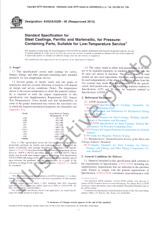We need your consent to use the individual data so that you can see information about your interests, among other things. Click "OK" to give your consent.
ASTM E1037-21
Standard Test Method for Measuring Particle Size Distribution of RDF-5
Translate name
STANDARD published on 1.10.2021
The information about the standard:
Designation standards: ASTM E1037-21
Publication date standards: 1.10.2021
SKU: NS-1037857
The number of pages: 3
Approximate weight : 9 g (0.02 lbs)
Country: American technical standard
Category: Technical standards ASTM
The category - similar standards:
Annotation of standard text ASTM E1037-21 :
Keywords:
ICS Number Code 19.120 (Particle size analysis. Sieving)
Additional information
| Significance and Use |
|
4.1?The particle size distribution of RDF-5 strongly influences the storage and handling characteristics of the fuel. Small particles tend to block flow through storage bins and feed hoppers, although correct bin and hopper designs will alleviate this blockage problem. 4.2?This test method for measuring size manually allows for accurate description of RDF-5 particle size distribution. Manual measurement is superior to sieving techniques, wherein particles may be broken by the size separation technique itself. However, hand measurement is more time consuming than sieving techniques. |
| 1. Scope |
|
1.1?This test method is used to determine the size distribution of a RDF-5 sample. Size is defined as the maximum length of the particle, where length is determined by the RDF-5 manufacturing process. That is, a pellet, cubette, or briquette all have a recognizable length. Fig. 1 displays the sizes and shapes of some RDF-5 particles. FIG. 1 RDF-5 Sizes 1.2?An air-dried RDF-5 sample is separated into categories of differing particle sizes. The size distribution is measured as the weight percentage of each size category. A graph of a function of the cumulative fraction of material by weight finer than particle size versus particle size is plotted. From this plot are taken values which describe the size distributionthe uniformity constant and the characteristic particle size. 1.3?This standard does not purport to address all of the safety concerns, if any, associated with its use. It is the responsibility of the user of this standard to establish appropriate safety, health, and environmental practices and determine the applicability of regulatory limitations prior to use. 1.4?This international standard was developed in accordance with internationally recognized principles on standardization established in the Decision on Principles for the Development of International Standards, Guides and Recommendations issued by the World Trade Organization Technical Barriers to Trade (TBT) Committee. |
We recommend:
Technical standards updating
Do you want to make sure you use only the valid technical standards?
We can offer you a solution which will provide you a monthly overview concerning the updating of standards which you use.
Would you like to know more? Look at this page.




 Cookies
Cookies
